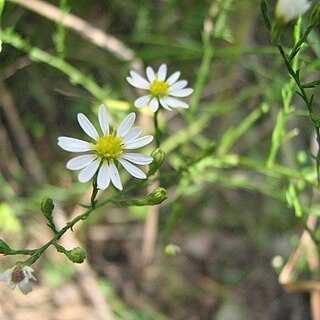Top Qs
Timeline
Chat
Perspective
Symphyotrichum depauperatum
Species of flowering plant in family Asteraceae From Wikipedia, the free encyclopedia
Remove ads
Symphyotrichum depauperatum (formerly Aster depauperatus), commonly known as serpentine aster or starved aster,[4][5] is a rare species in the family Asteraceae adapted to serpentine barrens, an ecosystem with a high concentration of toxic metals in the soil. It has been found in Pennsylvania, Maryland, and on some diabase glades in North Carolina. It grows to 50 centimeters (1+3⁄4 feet) and has white ray florets surrounding a center of yellow disk florets.
Remove ads
Description
Symphyotrichum depauperatum is a perennial, herbaceous plant that may reach up to 50 centimeters (1+3⁄4 feet) tall, with 1–3 stems. The leaves are narrow and generally 2–4 centimeters (3⁄4–1+1⁄2 inches) long. The plant produces numerous flower heads in branched arrays, each head with 7–14 white or, rarely, pink ray florets surrounding 7–17 yellow disk florets.[4]
- A plant in flower
- Flowers
- Growth habit
Remove ads
Taxonomy
Within the genus Symphyotrichum, S. depauperatum has been classified in subgenus Symphyotrichum section Symphyotrichum subsection Porteriani.[6] Its full name with author citation is Symphyotrichum depauperatum (Fernald) G.L.Nesom.[3] It was first described by American botanist Merritt Lyndon Fernald in 1908 as Aster depauperatus.[7]
Distribution and habitat

S. depauperatum is adapted to serpentine barrens, an ecosystem with a high concentration of toxic metals in the soil. It has been found in Baltimore[2] and Cecil Counties, Maryland;[1] Granville County, North Carolina;[2] and, Chester, Delaware, and Lancaster Counties, Pennsylvania.[1]
Serpentine aster has been called a "flagship species" of the unique serpentine ecosystem and was once thought to be endemic to these barrens,[8] but it also has been found to occur in a disjoint population on diabase glades in Granville County, North Carolina.[9]
Conservation
Symphyotrichum depauperatum is classified by the state of Pennsylvania as a threatened species because its range is restricted to a few limited areas, and the majority of its populations occur on sites threatened by quarrying, housing development, and industrial development.[10]
As of August 2022[update], NatureServe listed it as Globally Imperiled (G2); Critically Imperiled (S1) in Maryland and North Carolina; and, Imperiled (S2) in Pennsylvania. NatureServe's most recent review of S. depauperatum's global status was 3 October 1997.[1]
Remove ads
Citations
References
External links
Wikiwand - on
Seamless Wikipedia browsing. On steroids.
Remove ads






